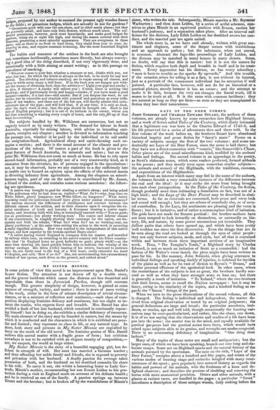MY SISTER MINNIE.
IN some points of view this novel is an improvement upon Mrs. Daniel's former fiction. The attention is not drawn off by a double story, and the graver incidents which cause the distress are less theatrical and improbable than those in Jeremiah Parkes, though still extreme enough. This greater simplicity of design, however, is gained at some expense of strength, variety, and matter : there is more of mere writing in the work, either in the form of minute description of trivial circum- stances, or in a mixture of reflection and sentiment,—each class of com- position displaying feminine delicacy and sentiment, but too slight to in- terest the reader, who expects force and breadth. Mrs. Daniel has also avoided a fault of her late husband, which consisted in continually repeat- ing himself: but in doing so, she exhibits a similar deficiency of resources. The main element of the story may be founded in nature, but the means by which it is conducted and the characters in which it is exhibited are pecu- liar and limited; they represent no class in life, or any natural type. In short, both story and persons in My Sister Minnie are engrafted by fancy on the stock of the old novel. The feminine genius of Mrs. Daniel endows this unreal matter with a fragile grace of form ; but criticism nowadays is not to be satisfied with an elegant teuuity of composition,— nor, we suspect, the world at large either. :illy Sister Minnie is the story of a beautiful engaging girl, but de- ficient in strength of will. Her aunt has married a German teacher ; and thus offending her noble family and friends, she is exposed to poverty and privation with her husband. A deadly passion for revenge takes possession of both, and the husband on his deathbed commits his share to his wife. To carry it out, she writes a lamenting letter to Lady Ger- trude, Minnie's mother, recommending her son Ernest Leiden to her pro- tection during a visit to England made on account of his delicate health ; and he is received as one of the family. A passion springs up between Ernest and the heroine; but is broken off by the watchfulness of Minnie's
sister, who writes the tale. Subsequently, Minnie marries a Mr. Seymour Warburton; and then Aunt Leiden, by a series of artful schemes, con- trives to place Minnie in an equivocal position with Ernest, excites her husband's jealousy, and a separation takes place. After an interval suf- ficient for the distress, Lady Edith Leiden on her deathbed avows her con- duct, and the married pair are again united.
The whole story is, as we have said already, written with great sen- timent and elegance, some of the deeper scenes with truthfulness and an approach to pathos ; but the substance, when not unreal, is common. Abstract the Iago-like proceedings of Lady Leiden, and the distress may be matched in many houses in many streets. Some, no doubt, will say that this is nature: but it is not the nature for fiction, which requires both depth and breadth in itself and in its treat- ment. Every apprentice has his distress, so has every schoolboy; "man is born to trouble as the sparks fly upwards." And this trouble, if the occasion arises for telling it as a fact, is not without its interest, just as a portrait of the commonest individual has its attraction if well painted. A particular face, however, will not do for an historical or a poetical picture, merely bebause it has an owner ; and the attempt to make it fit fails, because the very act changes the literal truth, till it ceases to be truth at all. It is the same with common incidents: they are natural as long as they are facts—as soon as they are transplanted to fiction they lose their naturalness.


























 Previous page
Previous page